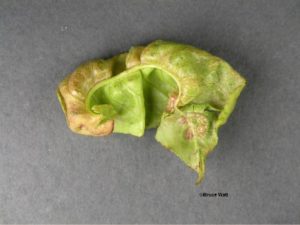Peach Leaf Curl
Pest Management Fact Sheet #5098
Authors: Dr. Alicyn Smart, Dr. Bruce Watt, and Abigayl Novak
For information about UMaine Extension programs and resources, visit extension.umaine.edu.
Find more of our publications and books at extension.umaine.edu/publications/.
Other Name: Leaf curl
Pathogen: Taphrina deformans
Introduction

Peach leaf curl is caused by the fungus Taphrina deformans. It occurs commonly in Maine on both nectarines and peaches. Although this fungus can infect the fruit, most losses are due to reduced vigor caused by defoliation. Subsequent refoliation uses energy reserves which would otherwise be used to produce fruit. The weakened trees are also more susceptible to winter injury. When the fruit is infected, it is likely to drop before maturity.
Spores that form on the surface of the leaf are the overwintering stage of the fungus. These spores are dispersed by the wind and splashing rain. They land in the cracks and crevices of the tree and in the bud scales where they rest until the following season. In the spring, spore germination is timed to coincide with the emergence of the leaf tissue. These initial spores (ascospores) germinate to produce another spore type (blastospores) which reproduce by budding. The spores fall onto susceptible tissues and germinate to penetrate the tissue directly.
As with most fungi, free water is very important to the infection process. Wet weather during bud-break and leaf emergence is favorable to the disease. Infections can begin at temperatures below 50°F, slowly.
Host Plants
- Peach and nectarine (Prunus persica), and cherries (Prunus), occasionally almond (Prunus dulci) and apricot (Prunus)
Symptoms and Signs
As the name implies, the disease is expressed as distorted or curled leaf tissue. These puckered, thickened leaves often have a characteristic reddish-purple color where the distortions occur (Figure 2 and 3). These symptoms may begin early in the season as the leaves are unfolding. Later the color turns to a powdery gray on the upper leaf surface as the fungus begins to produce spores. As the season progresses and the weather turns warmer and drier, the leaves turn yellow, brown, and finally defoliate.
- Figure 2. Infected Leaf. Photo by Dr. Bruce Watt.
- Figure 3. Infected Leaf. Photo by Dr. Bruce Watt.
Young branches can also be infected. Branches become stunted, distorted, thickened and may die. Leaves that grow from such twigs are also stunted and distorted. Fruit infections are not common but appear as wrinkled or meaning cool weather is thought to extend the infection period because the new leaves expand swollen reddish lesions which lack the normal peach fuzz.
Management
Peach leaf curl is readily controlled. There are no known sanitation or cultural practices that have been proven to be effective, and there are little to no peach or nectarine cultivars that are immune to the disease. Frost, Indian free, Muir, and Q-1-8 are some currently discovered resistant varieties. However, effective control can be achieved with one or at most two fungicide treatments. Spray either in the fall just before defoliation normally occurs or in the spring just before the buds begin to swell or at both times if the problem is severe. Some fungicides which are effective include: chlorothalonil, Bordeaux mixture, lime sulfur, and fixed coppers.
You should check your local town ordinance for any pesticide restrictions before application.
References
Broome, J. C. Peach Leaf Curl. May 2012. http://ipm.ucanr.edu/PMG/PESTNOTES/pn7426.html. 11 June 2019.
Ogawa, Joseph M., et al. Compendium of Stone Fruit Diseases. American Phytopathological Society, 1995.
Sinclair, Wayne A. and Howard H. Lyon. Diseases of Trees and Shrubs. Cornell University, 2005.
WHEN USING PESTICIDES, ALWAYS FOLLOW LABEL DIRECTIONS!
Alicyn Smart, DPM
Plant Pathologist and Director of the Plant Disease Diagnostic Laboratory
University of Maine Cooperative Extension
Information in this publication is provided purely for educational purposes. No responsibility is assumed for any problems associated with the use of products or services mentioned. No endorsement of products or companies is intended, nor is criticism of unnamed products or companies implied.
© 2010, 2019
Call 800.287.0274 (in Maine), or 207.581.3188, for information on publications and program offerings from University of Maine Cooperative Extension, or visit extension.umaine.edu.
The University of Maine is an EEO/AA employer, and does not discriminate on the grounds of race, color, religion, sex, sexual orientation, transgender status, gender expression, national origin, citizenship status, age, disability, genetic information or veteran’s status in employment, education, and all other programs and activities. The following person has been designated to handle inquiries regarding non-discrimination policies: Director of Equal Opportunity, 101 North Stevens Hall, University of Maine, Orono, ME 04469-5754, 207.581.1226, TTY 711 (Maine Relay System).



